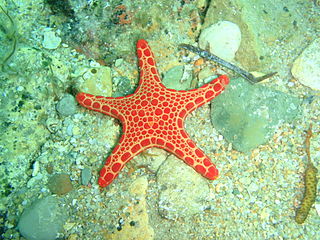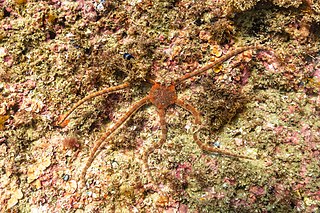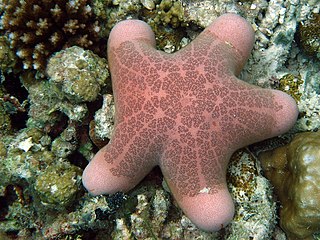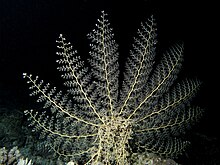
Astropecten is a genus of sea stars of the family Astropectinidae.

Ophiopholis is a genus of brittle stars (Ophiuroidea) found in oceans worldwide from tropics to temperate regions.

Ophiactidae are a family of brittle stars.

Ophiotrichidae are a family of brittle stars within the suborder Gnathophiurina.

Goniasteridae constitute the largest family of sea stars, included in the order Valvatida. They are mostly deep-dwelling species, but the family also include several colorful shallow tropical species.

Gorgonocephalus is a genus of marine basket stars in the class Ophiuroidea. Members of this genus are found in coldwater environments including the Arctic, the Antarctic, and deep-sea habitats. The scientific name comes from the Greek, gorgós meaning "dreaded" and -cephalus meaning "head", and refers to the similarity between these echinoids and the Gorgon's head from Greek myth with its coiled serpents for hair. The Greek mythological hero Perseus beheaded the Gorgon Medusa; when Perseus later dropped Medusa's head on the beach, her petrifying glance turned the nearby seaweed to stone, creating the first coral.

Ophioderma is a genus of brittle stars in the family Ophiodermatidae.

The Oreasteridae are a family of sea stars in the class Asteroidea.

Amphipholis squamata, common names brooding snake star and dwarf brittle star, is a species complex of brittle stars in the family Amphiuridae.

Astroboa nuda is a type of basket star from Gorgonocephalidae family. Its large arms are highly branched. It inhabits reef slopes exposed to current in diverse places such as the Red Sea and New Caledonia. During the day it coils into a tight ball. At night it spreads arms to form a basket to feed on plankton. They are part of the class Ophiuroidea, which is the largest class of echinoderms. The name Ophiuroidea comes from the roots, ophis, meaning snake and oura, which means tail, referring to the thin, spiraling shape of the basket stars’ arms.

Ludwig Heinrich Philipp Döderlein was a German zoologist. He specialized in echinoderms, particularly sea stars, sea urchins, and crinoids. He was one of the first European zoologists to have the opportunity to do research work in Japan from 1879 to 1881. Today, he is considered one of the most important pioneers of marine biological research in Japan.

Ophiactis is a genus of brittle stars (Ophiuroidea).

Astrocladus is a genus of echinoderms belonging to the family Gorgonocephalidae.

Euryalidae is a family of echinoderms belonging to the order Euryalida.

Ophionereis is a genus of echinoderms belonging to the family Ophionereididae.

Ophiomusa is a genus of echinoderms belonging to the family Ophiolepididae that includes: sea urchins, sand dollars and sea cucumbers. Ophiurida are similar to starfish; they both have a central disc and five arms sprouting from the disc. One of the main distinguishing factors of an Ophiuroid is its arms; the arms of an Ophiurida are longer, thinner, and distinctly separated in comparison to those of a sea star.

Asteronyx is a genus of echinoderms belonging to the family Asteronychidae.

Hemipholis is a genus of brittle stars.

Macrophiothrix is a genus of brittle stars.

Ophiotomidae is a family of brittle stars. It was originally introduced as a subfamily Ophiotominae under the family Ophiacanthidae. The family has a worldwide distribution.



















